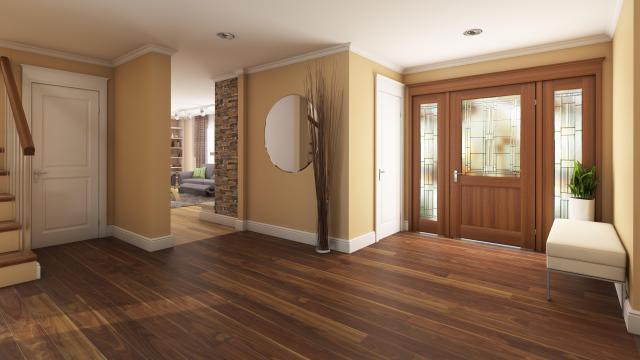Even if you’ve never once contemplated the flooring you walk on, buying a house will change that fast. There’s a reason everyone on House Hunters asks what kind of floors are in each house they visit: It’s because hardwood floors and laminate flooring are two very different things, but it can also be difficult to tell them apart. It’s a good idea to know exactly what type of floor you have, though, because hardwood and laminate flooring have very different impacts on your home’s value, comfort, and maintenance. Here’s how to tell if your floor is hardwood or laminate — and why it matters.
What is the difference between hardwood and laminate?
The fundamental difference between hardwood and laminate flooring is how it’s made: Hardwood is harvested from trees, whereas laminate is a fabricated product. Hardwood is cut from a wide variety of trees, milled down to size, sanded, and finished. Laminate is a composite product made up of four layers: A base layer made from a moisture-resistant material, a core layer of either high- or medium-density fiberboard that gives it its durability and stability, a decorative or “photographic” layer where the pattern and colour of the flooring are imprinted — essentially a very high-resolution photo of whatever material the laminate is imitating — and finally a wear layer with a clear coating to protect the floor.
While you can install hardwood from a wide variety of wood types to get a range of colours and appearances, laminate can be found in a much wider range of colours and patterns. It can mimic the look of hardwood very convincingly, but can also have different patterns and offer colours that you can’t obtain with natural wood. Most laminate is designed to look like hardwood, though.
Hardwood is potentially a much longer-lasting flooring material than laminate. Properly cared for, hardwood can last indefinitely, and even if it becomes worn or damaged, it can often be refinished, with the top worn layer sanded off and a fresh coat of stain and sealant bringing it back to a brand-new appearance. Laminate flooring, on the other hand, cannot be refinished and typically has a finite lifespan, with the higher quality stuff lasting 10-20 years with normal wear.
There’s also something called engineered hardwood. This is basically high-quality plywood with a veneer of real hardwood layered on top. The main difference is cost, which can be as low as $US3 ($4) per square foot to install, and durability: While the top layer of hardwood will wear almost as well as the real thing, it can only be refinished once or, at most, twice. Engineered hardwoods won’t last forever like real hardwood, but they’ll last much longer than laminate — up to 30 years.
How to tell the difference
Since hardwood is a superior material in most ways and laminate will eventually need to be replaced, you need to be able to tell them apart. Modern laminate flooring can really fool the eye and look a lot like hardwood flooring without offering the same durability. If you have what look like wood floors, here’s how to tell what material you’re dealing with:
- Repeating patterns. Even the most expensive laminate will only have a limited number of “patterns” giving it that wood-grain look. Examine a few planks closely and look for repeating features. Knots are a good place to start, as they’re relatively large and if you spot two that look exactly the same you’ve found your laminate smoking gun. If every plank looks unique, it’s probably real wood.
- Look for stains and dents. Ironically, despite being a more durable material overall hardwood is more prone to stains and dents. Laminate surfaces can be very resistant to both, so if you have some imperfections in your floor it’s likely real wood. Laminate can be scratched up pretty easily, however, so some scratches isn’t the smoking gun you’re looking for.
- Look for nailheads and staples. Hardwood flooring is typically installed by nailing or stapling the planks onto the subfloor. Laminate is usually glued down or “floated.” If you can see nailheads or staples here and there, it’s most likely hardwood.
When it comes to hardwood versus engineered wood, the only reliable way to tell the difference is to look at the sides — if you see layers, it’s engineered. But this requires access to the sides of the planks, which you typically won’t have when dealing with a finished floor.
Home values
The reason you want to know what kind of flooring you have isn’t just about maintenance; it’s also about your home value. Real hardwood floors add a lot more value to your home — in fact, more than half of potential home buyers will pay more for a home with hardwood floors. If you think you might someday sell your home, figuring out what kind of floors are in there will help you set the price appropriately — and if you’re buying a house, knowing the type of flooring will help you make the right offer.
The rule of thumb on laminate and home value is simple: If you’re upgrading from carpet, vinyl, or some other cheap flooring, laminate is a good investment in terms of home value. If you’ve already got hardwood floors, laminate would be a step down, so look into refinishing what you have or replacing it with a similar material.

Leave a Reply
You must be logged in to post a comment.